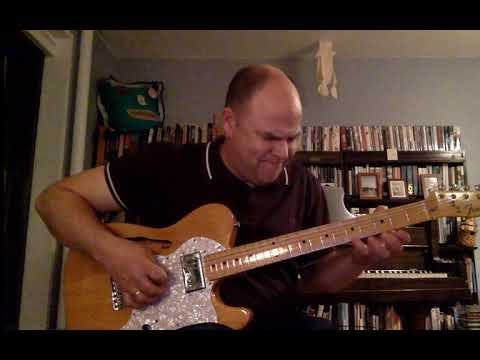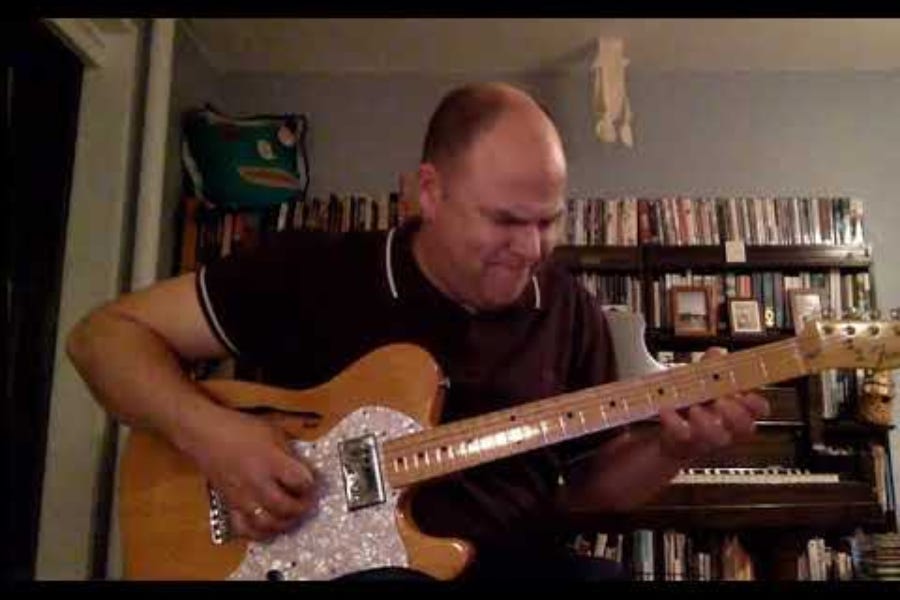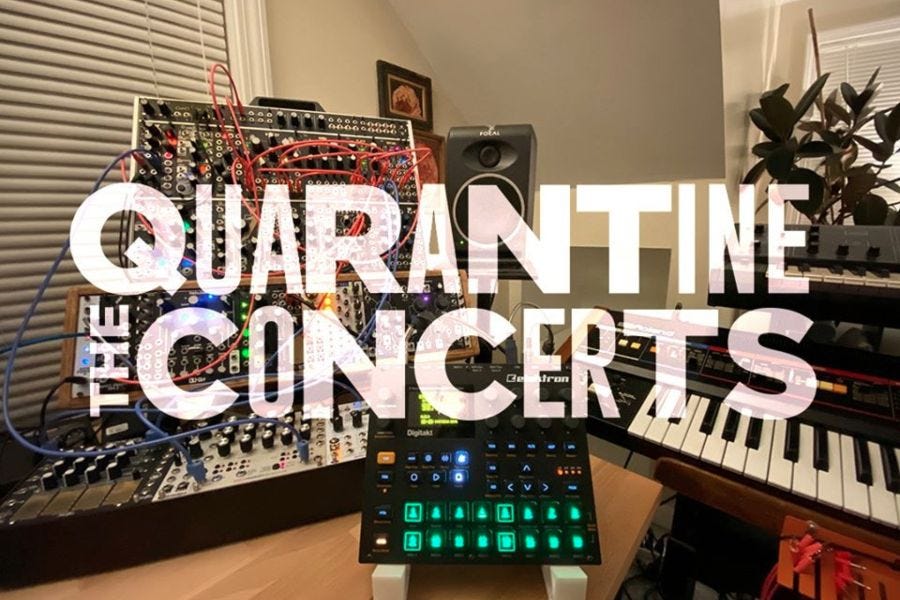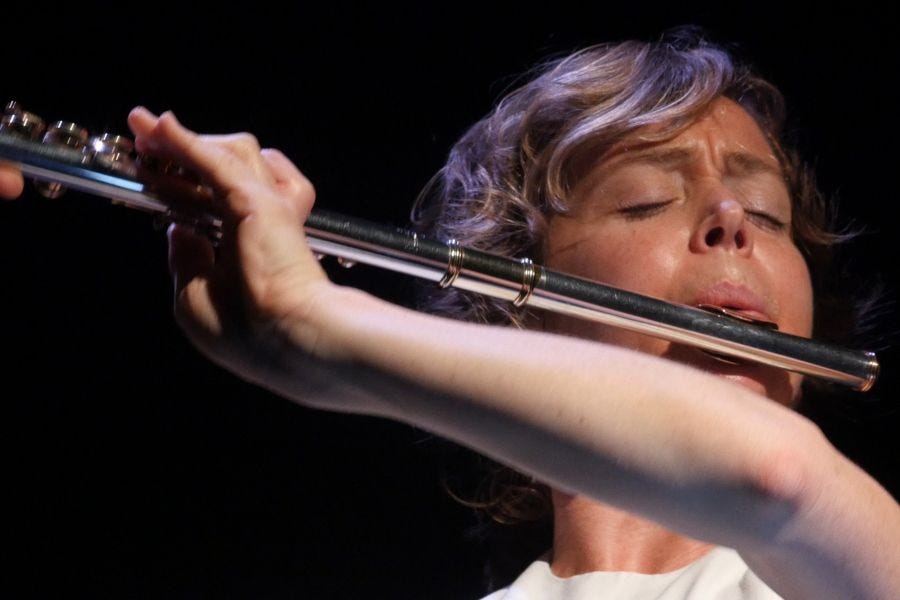Singles Going Steady
From its headquarters in Chicago, Experimental Sound Studio is bringing live new music to a global audience via Twitch—and putting much-needed funds into the pockets of participating artists.
Preamble: Into the Groove
Before we get rolling with the newsletter at hand, I want to apologize to subscribers for failing to deliver two installments last week. I’m working very hard to establish a rhythm that will enable regular, predictable delivery, but unfortunately the moment in which we’re living is anything but regular and predictable. Thus, this issue, which ought to have been delivered late last week, arrives instead today.
That said, the next installment of this newsletter will arrive on Wednesday, followed on Friday by the first article created exclusively for paid subscribers: a guide to new and upcoming recordings, which will be updated continuously online. So get ready for a small deluge of Night After Night this week, and bear with me as I inch closer toward my target delivery dates of Tuesday and Friday mornings.
(Finally, apologies to readers who may have noticed that the emailed version of this post stated it was for paid subscribers only—that was a small error, now fixed.)
Interview: Experimental Sound Studio
My initial exposure to The Quarantine Concerts happened entirely by chance one evening in early April, when the punk-rock prodigy turned avant-garde ambassador David Grubbs retweeted a notice about an online concert in which he would be performing. The lineup for that concert would be the envy of any venue or festival, anywhere: Grubbs, Joe McPhee, Ikue Mori, Claire Chase, Ken Vandermark, and Arto Lindsday, all playing solo sets.
Thing is, the show was less than an hour away. In the real world, responding to such a last-minute invitation would prove challenging, at best. But seeing as how the concert was being held on the streaming platform Twitch, and given the eternal now-ness of pandemic-enforced extremely online existence—well, why not?
The event was produced by Experimental Sound Studio, a Chicago nonprofit devoted to hosting, promoting, and preserving sound-based art. And despite technical issues that would shuffle McPhee’s set out of sequence (which could just as easily have happened in the real world), the concert – Sequesterfest (Vol. 1), curated by the Chicago gallery and performance space Corbett vs. Dempsey – was a refreshing burst of creativity and spontaneity. What’s more, the presence of fellow audience members, visible on a live chat, offered a feeling of connection sorely lacking in recent weeks.
Intrigued, I dipped into numerous additional ESS Quarantine Concerts: mostly (though not wholly) solo sets, presented by a range of artists that included Aaron Dilloway, Sarah Davachi, Thurston Moore, Mats Gustafsson, Red Desert, and Susan Alcorn. Launched in late March, the series was conceived to run through the end of May. The term “experimental” is embraced in its most expansive form, encompassing new-music composers and performers, free improvisers, electronic producers, indie singer-songwriters, and more.
To learn more about this fascinating initiative (which by late April had reached 104,000 viewers and distributed more than $20,000 to artists), and about the individuals and institution responsible for bringing it to life, I organized a Zoom conference with three ESS executives – managing director Adam Vida, technical director and chief engineer Alex Inglizian, and development & outreach director Olivia Junell – and two musician-curators who helped to develop and curate the Quarantine Concerts series, Ben Billington and Daniel Wyche. (The interview was edited for length and clarity.)
STEVE SMITH: Before we talk about the Quarantine Concerts specifically, I’d like to go around the meeting table, so to speak, and hear from everybody about how you came to be involved with Experimental Sound Studio.
ALEX INGLIZIAN: I started working at Experimental Sound Studio in late 2006, pretty much right after I graduated from the School of the Art Institute, here in Chicago. I was connected with Lou Mallozzi, who was a professor there and one of the co-founders of Experimental Sound Studio, and the executive director for 31 years. I dove in headfirst, right after school, and started working with the music community in Chicago. My passion was technology, recording, engineering, and electronics, so I really explored those realms, while moving forward with growing Experimental Sound Studio and how it works with communities of musicians and provides space for recording sessions, workshops, and artist residencies.
One thing I want to amplify from the start, particularly for readers outside of Chicago, is that Experimental Sound Studio is in fact a physical, terrestrial space, not solely or even mostly an online initiative.
AI: Yeah. When Lou started, it was in his apartment. But a couple of years later, after I joined the crew, it had just moved to a space in the Edgewater neighborhood, on the north side of Chicago. It’s a small two-story building. On the top floor, we have a gallery that we call Audible Gallery, where we present sound-focused work, anything from 2-D work to performance and installation. On the first floor is a full-service recording studio with a large live room, a separate control room, an isolation booth, a nice collection of equipment and microphones. A big part of what we do is offer those services to musicians at a very relatively affordable rate, creating a place where musicians can not be really worried about watching the clock every hour and knowing their bill is ticking away. In addition to that, we have archives and a secondary post-production studio in our space.
Adam, how did you become involved?
ADAM VIDA: I joined ESS in 2008, just a couple of years after they to the Ravenswood building. I came in knowing the community a little bit more from a musician’s perspective as an improviser, knowing all the musicians. Alex and I hit it off quickly and settled into what roles make sense for us, where I was managing things and Alex became the chief engineer. We loved what the shell of ESS was, as a vision that Lou and Dawn Mallozzi had started as founders back in 1986, and we wanted to find a way to fit into it, but also grow it in the right sort of way.
The community was a little older than Alex and me at that time, and it was a very specific radio art, sound art, performance art kind of thing. We knew that it was on the edge of welcoming an even larger community of younger people who were coming from SAIC and other colleges, and a lot of really incredible improvisors. The thing about Chicago is there are so many incredible musicians and artists, and we just need to find a way to get them work, and set up situations where they can play with each other and make art together.
So we started booking more and more live performances, and we grew the community quite quickly, in a way where we let everyone know: this is your place, too. We want to be a hub for all different types of genres that would fall into experimental music: electronic musicians and improvisers, but also people playing rock music and new-music groups. They all are welcome, and then they would cross pollinate into each other’s projects.
And then COVID hit, and we had to pivot very quickly. But it was not that hard once the technical aspect was in place, because we already knew all those musicians. All that community, this energy… that wasn’t going to just disappear. It needed a place to go. So we had to find a way to keep this cross-pollinating art project going. And The Quarantine Concerts turned into a new way of making art altogether. It’s not a live performance, really. It’s different, and it’s something that is really exciting and fun.
Olivia, how did you find your way into this mix?
OLIVIA JANELL: I’ve been with ESS for five years now, and it was amazing to be able to come into an organization that already had such a strong foundation, but also a history of flexibility and forward thinking and nimbleness. And I think that that could be said for the city, which has a very long history of experimental arts and grassroots music organizing. There’s so much room to be a part of that, and there’s really very little competition. Which is where Ben and Daniel come in: they’ve been longtime organizers in the city and longtime friends of ESS, but also have their own initiatives. The fact that we were all able to come together around The Quarantine Concerts, and put all of our networks and our energies together, has been amazing.
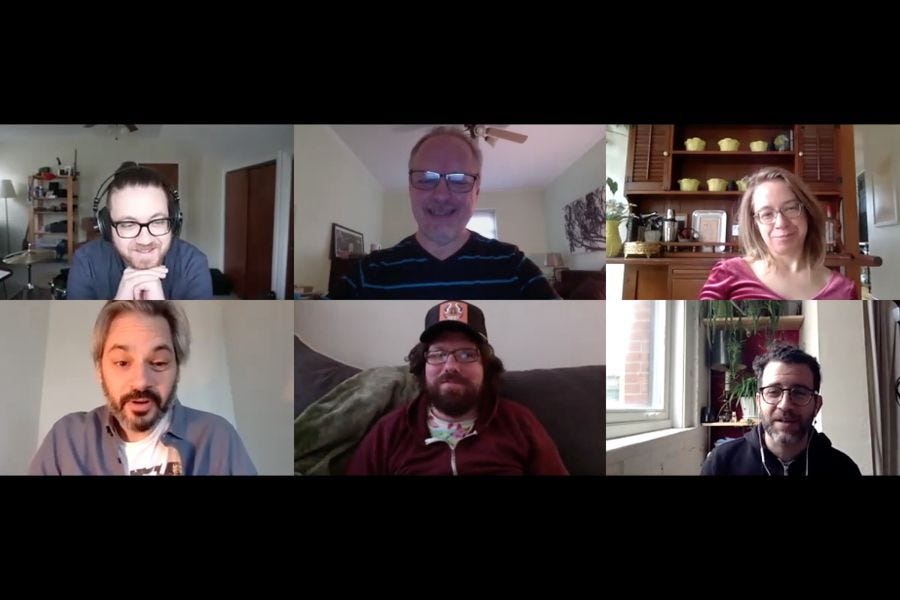
Ben and Daniel, could you talk about your own work, and how it intersected with the ESS mission?
DANIEL WYCHE: I originally started organizing things in Chicago with Elastic Arts around 2013, and I've just been a fan of the ESS for as long as I’ve been going to stuff in the city. It’s such a amazing space, and everybody is so serious about things sounding good, and really pushing things. I played [ESS series] Oscillations in 2015, and then Option two years ago, but we had never really worked together curatorially or organizationally.
I was supposed to go on tour in March, and it just got canceled. So I was talking on Facebook: should I go in on tour from my house, do a different set every other night, something like that? Olivia reached out – we’re thinking about doing these streaming things – and I’m like, let's do it. Then Ben got on board too, and obviously Ben and I have worked together quite a bit, as curators and as bandmates.
I feel like everybody is so hungry for this. Everybody is so excited to solve problems. Things will come up: okay, how do we do this? And then independently or collectively, everybody’s like, let’s try this website, we’ll try this equipment, we’ll try this software, we’ll talk to these people. Everyone really reaches out and digs in, and we were able to get this series up and running in about a week.
On a personal note, I think that if it hadn’t been for spending so much time basically like it is right here, with these guys in this view, I would have lost my mind. It was really nice to have a very cool group of people to work on a project with. It’s like: okay, we’re all just going to build this sand castle.
Ben?
BEN BILLINGTON: I’ve been in Chicago for 15 years as a full-time musician and organizer. I’ve been working as an organizer with tons of different nonprofits and music venues, across all mediums—nothing too specific, but definitely veering towards the more abstract realm. I’ve been running the Resonance Series out of a venue called the Hideout for the last four years. And my involvement with ESS: we’ve just been pals for as long as I’ve been in Chicago, pretty much.
Then a couple of years ago, Olivia asked me to be part of the development committee helping to organize the gala, and in the last year we dove into more individual giving and grant writing and stuff. And then, as Daniel was saying, the day after “shelter in place” was initiated, Olivia or Dan hit me up – ESS is trying to organize this thing, we’d love your insight and your energy in this – and of course, I said yes. I don't think any of us had any idea what was going to happen, whether it was going to be a one-show thing or just a couple of shows, or that it was going to work at all.
And then within that first week, we had three shows booked. It was controlled and meticulously crafted, but also spun out into this bigger thing that we all sort of didn't anticipate. I'm honored to be a part of it.
What was the eureka moment where somebody said, Hey, we could actually pivot to doing some pretty hardy full-time programming online, and also making it initiative where it could be a money-generating thing meant to put funds into the pockets of artists who otherwise were out of work?
OJ: It was pretty immediate. As soon as things started shutting down across the country, on Facebook and on social media you saw post after post about gigs getting canceled. And artists, being some of the most flexible and nimble people, but also one of the most vulnerable populations, were already all pivoting. They were trying to figure out online shows on all of these different platforms. So our first thought was, how do we get everybody together? It was overwhelming and also inspiring to just see so many shows, and it was an immediate impulse to try to gather these networks.
AI: There was this funny moment that first weekend where we were all getting excited for this idea of streaming from the studio. We were like, okay, we can't have in-person audiences anymore, but we have this facility, and we've been streaming about five years for our Monday night concert series. We have the setup, the infrastructure: nice cameras, nice equipment, high quality audio. We can just do this from our studio, one-on-one, and we'd still bring musicians in. We could still be making records. And so we almost tried to lay all that out within a couple of days, and I remember I was working all day long, just thinking about how to make this happen.
Then all of a sudden, the world changed again: wait, we can't be one-on-one together in a room with strangers now. But there was all this momentum and excitement—now, how do we pivot again? Our social-media feeds are all musicians, so opening up Instagram and Facebook was so depressing. All my friends are losing income. They're freaking out. What are they going to do?
So it was sort of simultaneously overwhelming and exciting, because everybody started streaming on their own platforms, on their own accounts. I don't know if you're an Instagram user, but you get these notifications when your followers go live—and I'd never seen so many of these notifications. Everybody started going live, and everybody started saying, donate to my Venmo, or here's my PayPal. We realized really quickly that this wasn't the right way forward.
What I started thinking about is everybody was having their own house show. What's the idea of the venue now? How do we get people out of their homes, where only their friends show up to listen to their music, and start to build a new audience and a space for people to all collectively join together? That's what led us towards what's happening now. Ben and Daniel were moving towards really quickly, trying to get all this stuff going, and we wanted to do a test show. We started with this first show, it felt really good, and the three of us played. And we actually had people watching, and I think we made $20 that night or something in donations, which was really exciting. It was like: wait, this can happen if we keep pushing it forward.
This was actually my introduction to Twitch—I'm not a gamer, so I was not familiar with the platform. What's the advantage of using that platform?
DW: There were a whole lot of reasons to go to Twitch. For one, we first did it on YouTube because that's what ESS was using already, and that's what we were familiar with. I don't think any of us had used Twitch before – maybe some of us – and I think a lot of people in our community maybe have bad associations with gamers, which I do think is unfair. I'd like to be on the record saying that I think those associations are very unfair. A lot of those people are awesome, and that community is really strong in lots of ways, though it does have its problems, like any other one.
So the first show we did… our show, with the three of us, was like our soft opening. But the real first show, with Alejandro Acierto and Molly Jones and a bunch of other folks, started on YouTube, and it kept crashing. We kept getting reported.
AI: Yeah, YouTube kept kicking us off.
AV: We were getting flagged.
DW: We we're getting flagged, specifically.
AI: “Inappropriate content.”
DW: And it wouldn’t tell us what it was! [laughs] I think Alex said you had to email somebody?
AI: You have to appeal and email someone. So we kept like rebooting it… and we were just, like, screw it.
DW: So we switched over to Twitch in the middle of the show. Alejandro and Molly both started sets that they cut short, and then we switched. And I think Alejandro was the first one to use Twitch. This happened within 10, 20 minutes—we literally moved the venue.
AI: I was in the back, behind the scenes, furiously signing up for an account, reading instructions.
AV: We had already researched Twitch, so we were thinking about it. Alex had done a lot of the legwork in learning that this was maybe going to be a good one for us. We just didn't think we were going to have to adjust in that half hour.
DW: Once we got on Twitch, there were a few things that I think people still found a little bit unappealing about it. One thing was that you had to subscribe to three channels in order to sign up. Now, there's a ton of music channels. But when I first signed up, I was like: I guess I'll just pick some video games I don't know anything about. [laughs]
Then it got going, and it worked really well. That was the main thing: it worked. And everybody was so unbelievably supportive; everybody in the chat was like, “it’s great, don’t worry, we’re all here for you” while we were solving tech problems.
AI: One of the biggest challenges – especially for me being a engineer, and usually having control over the quality of the technology – is that in the end, the quality is limited to what the musicians have at their house. We can help them use it to their best ability. I’ve found in a lot of cases, people can use some tips with things like microphone placement, audio levels, gain structure, and all these little things. In the end, there is no way to have any sort of consistency of quality. But I think we’ve all come to kind of love that chaos. And artists are starting to use it as a new medium, and use it intentionally.
AV: I think it’s safe to say that the community that came over with us to Twitch weren’t Twitch people to start with. There’s something that happened to us on, I would say, March 21st, that first real, full concert day, where you realize that it’s working. People are coming here and we’re talking about music, we're chatting about the music while it’s going on, and it feels like we’re at a concert. Performers are getting this energy transference that they’re used to having on stage every night, where they’re giving off energy and then it’s coming back to them, and that’s what they’re missing.
What’s more, we’re all in the same place, so donations feed off each other – “Hey, I just donated, it’s so easy, go to this button” – and they increase and increase. Having the community in one place, like a venue, is the key for making more money for these artists, as well. So we got that excited feeling: whoa, this really feels like a performance, and this is fun. Then as the nights went on, and we could see other people, other musicians we’re working with and other fans, coming, and be getting that same exciting feeling, we knew that this was going to grow, because somebody new is getting that feeling with each show that comes by.
AI: Some of my favorite moments are when musicians play a set, and then they show up in the chat room afterwards to jump in, and then everyone’s like, great set! Or, it was awesome, or how did you do that, or what was that thing you were doing? It’s so cool when they rejoin afterwards.
Screenshot of Quarantine Concerts performance by Brian Chu, live from Hong Kong, on April 22, 2020
I'm curious about how you approach outreach. The reason I stumbled into your space initially is because I saw a notice on social media from David Grubbs, saying he was going to be playing live in an hour. I clicked on the link, and then I sat and watched… and I watched, and I watched, and I donated, and I came back again on other nights to watch concerts by artists who I didn't know. There was one show in particular, a long sequence of sets in a single day – where I made the leap from donating to the artists to subscribing to the ESS Twitch channel. What is the benefit of subscribing? How does that assist artists and you?
AI: I guess I can answer that… though by the way, I’m learning new things about Twitch every day. I’m always emailing or texting these guys, like: I figured out this new thing! Recently I figured out how to make a custom emoji in the chat room. What’s cool about this Twitch atmosphere is that that’s an incentive. If you subscribe to our channel, you get to unlock custom emojis that we designed, and you get to use them in the chat room where other people don’t, so it creates this fun incentive system.
We were lucky: we have a SoundCloud Pro account, which we use a lot for our archives. And once COVID hit, Twitch and SoundCloud partnered for a program to assist artists, to essentially fast track new Twitch users to what's called affiliate status. It basically makes you a partner with Twitch, so you can monetize your channel. At our current affiliate level with Twitch, we get a 50/50 split of the subscriptions. Right now, ESS is making over a hundred dollars a month in current Twitch subscriptions. The user gets ad-free viewing, and then there’s a couple of cool things, like you can cheer in the chat, or you can do the special animations that like non-subscribers can’t do, and other kind of fun interactive stuff.
We’re trying to engage people to subscribe because we really like this model of giving 100 percent [of donations] to the artists—but we’re in the background trying to generate this padding, because we know there’s going to be shows where it’s not going to make a lot of money, or the audience is going to be low. So ESS is trying to kind of build this padding where we can at least offer artists a minimum, and chip in when things are low.
AV: We set a minimum at $50 per artist, and if the donations don’t equal that, then ESS will donate it, because sometimes we get off-hour donations who just want to help the cause. You came in with the Corbett vs Dempsey Sequesterfest, and maybe a lot of those artists are not as desperate for money immediately. A lot of them are donating to the cause, so that ends up going towards other artists. A show like that brings in a lot of money, and a lot of viewers. It’s important, for the whole thing to grow, to have some very high-profile acts as well, because it ultimately helps all the artists involved.
One thing I came to appreciate quickly is that the diversity of your offerings is balanced with a consistency of quality and strong curatorial vision, to the extent where when I get a push notice or email indicating that you've gone “on the air,” I don’t even stop to check what’s on; I just click the link and start watching. How is the programming handled by this team?
DW: I think there are a couple of nights that the people in this room right now have done. But I’m officially not curating any more shows, at least not for the foreseeable future. Essentially, with a few exceptions, we now are curating the curators. And I think that's part of why it's so diverse and good: what we’re doing is now partnering with other people who are doing programming elsewhere, or just folks who wanted to do a show, and letting them kind of use our facility essentially to put on a bill.
So Ben and I just got an email this morning from Jonathan Williger from D.C. I'm working with Rhizome in D.C., also. We had ASRA Booking, which was the Aaron Dilloway show. We had Corbett vs Dempsey. I mean, there’s some ESS Presents; I know Olivia has a night, and Resonance, and other stuff. But really, at this point we’ve farmed all that out. Putting one of these shows on is actually a ton of work. I’ve never been so tired as I was after doing one of these shows. I think all of us were exhausted.
AI: I almost had a heart attack, I think.
DW: So at this point we’re kind of just keeping the lights on and making sure people have a spot. We’re running the calendar, and we’re organizing when people’s things are happening. If someone in this group is a point person for a curator, then it’s our job to make sure they have all the tech information that Alex has so amazingly prepared to help them and their artists troubleshoot, help organize sound checks, and things like that that happen beforehand.
AI: One thing we learned really quickly is that the work is overwhelming if we want to do it at the scale we to do it. And for me for tech, and everybody for email communication and gathering marketing materials and all of this, it’s a whole other full-time job just to do this part time. That's why we’re so lucky to have Ben and Daniel, because their networks of not only artists but curators branch this out exponentially. So now, really what we are is curator wranglers. I’ve created these documents; we’ve collaborated on how they’re laid out. We can just send them to a curator, and then the show can happen ideally in the background. That's not really how it works on the ground, but what we’re trying to shoot for is to build this infrastructure that’s kind of autonomous. Now, all the curators are sort of doing the work for us, and we’re keeping it afloat. It’s been extremely successful.
OJ: I think that that answers your question about how we’ve been marketing it, too, because it’s been fairly organic: just the sheer diversity of curators. We have people all over the world who are curating, and then they get that out to their networks. And then, like you, they like what they see, and then they’re getting pinged for new shows. It’s been fairly organic in that way. It’s definitely a ton of work, and that’s one of the reasons to have the curators. But we set up this model because we did want a bunch of voices in the room, benefiting as many different artists from our community as we could, and to be a platform versus being gatekeepers.
You've got programming in place through the end of May, which is what you’d originally planned. Is there potential for this to continue beyond that point, and even possibly beyond the crisis completely?
AV: Yeah, definitely. We realized that people don't actually want us to stop when the quarantine is over, so we're trying to figure out how to do it—and we are actually learning how to make it so it isn't a stress out every night. There's a learning curve, and people are figuring out more and more how to stream with good sound at home. If they sign up for Twitch, they can practice on their own channel, so people are getting better at it. Curators are getting better at helping the artists with it, and then us curating the curators and serving as point people: we can oversee it, but we're having to not control it quite as more quite as much.
And then moving into June, we already have some people that are definitely interested. We're reaching out to organizations like Roulette and Issue Project Room. We want these organizations to come through, and there's just so much interest that we're going to find a way to continue on, for sure.
Watch the Quarantine Concerts live on Twitch, and stream archived shows from the Experimental Sound Studio website. ess.org/the-quarantine-concerts
Coming soon…
The dynamic flutist Claire Chase talks about the four-hour virtual marathon concert she will present from home on May 14, a collaboration with Music on the Rebound to benefit the New Music Solidarity Fund.
